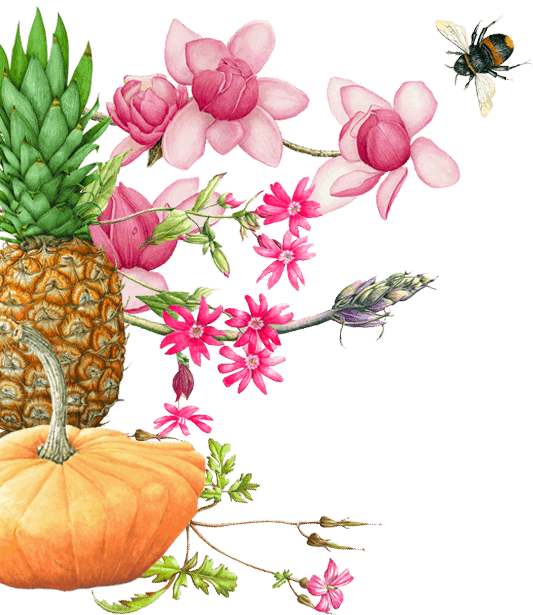Stepping into Spring
- 27th Feb 2019
As we write our February garden update, a plethora of new blooms continually erupt within the gardens. Light pink camellias lead the march quickly followed by vibrant deep pink rhododendrons, below their boughs, drifts of white snowdrops and clusters of eccentric hellebores line our paths whilst daffodils take the spaces in between. This garden in rebellion is not a planned fight against the seasons but more a sign of just how mild winter has been.
Meanwhile, within the sheltered Productive Garden walls, the age-old tradition of a deep spring clean is not forgotten, the Productive Garden Team leaves no bed unturned and no glass pane unwashed as they prepare for another year of new growth. There is a feeling of anticipation in the glasshouses as rows of heritage seed show signs of new life, small green shoots reach up no more than an inch in the expectation of finding sun, ready for their relocation into their newly prepared patch. This moment of new growth is the result of months of preparation and planning, the seed from last year was harvested and carefully stored for a time when it is needed again, such is the way when preserving these heritage plants.
The Kitchen Garden will see plenty of new arrivals this spring.
Heritage Peas
Veitch’s Western Express
Heritage Onions
Roscoff, Bedfordshire Champion, Red Brunswick, Ailsa Craig.
Broad Beans
Bunyards Exhibition & Red Crimsons.
Flowers
Antirrhinums and Sweets Peas.
Leaving the walls of the Productive Gardens behind, you enter a landscape stirring with wildlife. The woodlands and hedgerows are yet to put out their summer leaves leaving large open expanses where robins and mistle thrush are easily spotted. If you are lucky you may even hear the clacketing sound of a nuthatch or see him as he masterfully carves his new summer home. Deep in the Lost Valley, goldcrests skip from branch to branch methodically searching for a small insect feast and then there are the lesser spotted woodpeckers with their bright red hats that are found dipping between old decaying trunks.
The woodland edge is also not to be missed, roe deer can be seen here, each member of a herd taking a turn to feed as the others stay upright and alert. After a few days of rain, it is not uncommon to also see our barn owl here as she silently drifts along the margins looking for an unsuspecting mouse.
Our waterways are equally as exciting, the upper ponds at this time of year begin to boil as toads and frogs spring into action. After a mild spring evening, it is not uncommon to find large gloopy strings and blobs filling what was once the Italian Garden pond. This amphibian orgy is no safe ordeal as our resident heron strides along the edge of each pool picking off any frogs too preoccupied with love.
Delicate yellow primroses, believed to be the first flower of spring, though our snowdrops may have something to say on that matter, now line our woodland walks. Crocuses lift like small lilac hot air balloons from their wintery sleep, offering beautiful contrast along the edges of the Jungle’s top pond. Further, from the ground are fuscias with their deep purple and pink leotards, reminiscent of floral ballet dancers bobbing gently in the wind. Above, hazels take a chance to put on their own display as light-yellow catkins swing clinging on to the branches for dear life. Finally, our magnificent magnolias have arrived and in what style too, their giant pink flowers bending the branches they decorate, a sure sight that spring is on its way.
At the end of January, visitors and staff joined together in The Barn, crossing fingers and toes whilst witnessing the first glimpses of new life, as we scanned our pregnant rare breed ewes. We’re delighted to announce that in total; 17 Longwools, 1 Herdwick, 1 Ryeland, 4 Kerry Hills and 6 Jacobs were all confirmed as ‘with lamb’. We’re looking forward to welcoming an incredible total of 42 lambs who will arrive as 2 sets of triplets, 8 sets of twins and 16 single lambs, all over the Easter period.
If you’re visiting us in the next few weeks, you’ll be able to recognise for yourselves which of our ewes are pregnant and how many lambs they’re expecting by the coloured dot on their bottoms! If the dot is blue then they’re expecting a single lamb, red will be twins and green indicates triplets!
Finally, an event we are very excited for is our first ever Native Pig Show. To coincide with National Pig day on 1st March and also February’s start of the Chinese year of the Pig, our livestock Team plan to introduce you to all 11 UK Native breeds of pig, all at the same location at the same time.
















